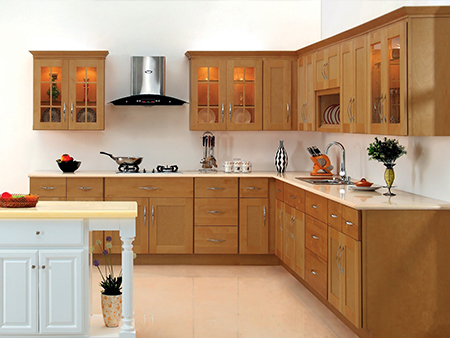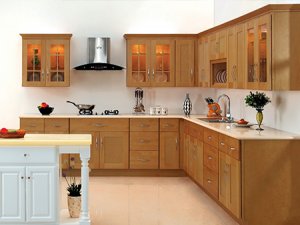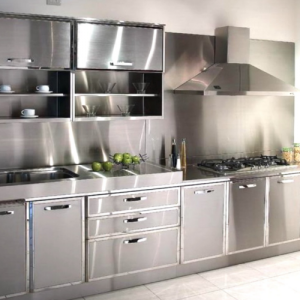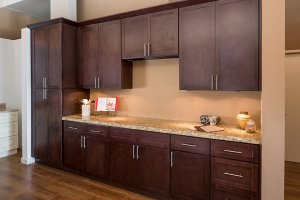
Have you been planning to build a new kitchen cabinet or you’re just contemplating on renovating it? Well, here’s something you should know and consider before you make a move. What your kitchen cabinet is made of will affect how it looks and how it’ll withstand daily wear and tear. So, make sure you choose the right materials that best suit your lifestyle and taste.
From over-the-top to budget-friendly materials, here are the best options you can use for your kitchen cabinets:
1. Solid Wood
 Solid wood is, by far, the most popular and preferred material used for kitchen cabinets. Perhaps, that is because it is a completely renewable source and it’s non-toxic.
Solid wood is, by far, the most popular and preferred material used for kitchen cabinets. Perhaps, that is because it is a completely renewable source and it’s non-toxic.
The most common solid woods are teak, sheesham, and marindi. Their surface can be stained or varnished, but you can also have them painted depending on your color choice.
Advantages of Solid Wood
In case you are in doubt whether or not to use solid wood, let these reasons convince you why you should use it in your kitchen cabinets:
- This type of wood is widely available in a wide assortment of textures, colors, and grains.
- Solid wood is much preferred because of its natural variation that creates a distinctive look.
- It can adapt well to both modern and traditional designs.
- It can be easily cleaned with gentle cleaning solutions.
Disadvantages of Solid Wood
Below are a few reasons why solid wood might not be the perfect choice for your kitchen cabinets:
- Buying a solid wood of poor quality will result in warps and dents.
- Sudden changes in the levels of humidity can cause damage to the surface and the core of the wood.
- This type of food requires frequent polishing to maintain its beauty and smooth texture.
- It can be a bit costly and difficult to install.
2. Laminates
Knowing that solid wood is at risk for infestation and damage, some households would prefer laminates. This type of wood is comprised of layers of plastic resin, a paper with a printed layer of designs and patterns, as well as an overlay of a sturdy plastic film.
To install a laminate in a kitchen cabinet, products like MDFs and plywood are used. And then, a decorative sheet is pasted onto the board. Although this is a cheaper option that solid wood, it is more durable and sturdy.
If ever you decide to use laminates for your kitchen cabinets, be sure to choose the high-pressure laminates or the HPLs. They can resist moist and are more durable.
Advantages
Aside from the wide selection of designs, here are other advantages of using laminates:
- Laminates are more durable yet affordable.
- It is possible to achieve your desired design with a laminate.
- Its surface does not fade quickly. It does not even require frequent polishing, which is contrary to solid wood.
- Laminates can resist moisture because they are coated with a layer of thin transparent plastic.
Disadvantages
Like other wood choices, using laminates have disadvantages. These are:
- If not properly installed, the edges may peel off.
- Laminates are non-renewable materials.
- There are laminate varieties that emit greenhouse gases, which are harmful to the environment.
3. Wood Veneers
Wood veneers are basically sheets or slices of solid wood that are placed over a composite material like laminates. In order to achieve a certain texture or colour, veneers are often stained and polished.
This material seems like a combination of solid wood and laminates, but it has the ability to reflect the real grains and the beauty of a wood.
Advantages
Below are a few reasons to use wood veneers for your kitchen cabinets:
- Wood veneers are more economical and sustainable unlike solid wood.
- They can make a hard-edged kitchen cabinet door look softer and smoother.
- They can be easily treated to achieve various finishes, such as semi-gloss, matte, and high-gloss.
Disadvantages
Why shouldn’t you use wood veneers? Here are some reasons:
- They tend to lose their color once exposed to natural light.
- Like solid wood, they require polishing after a certain period of time.
- If not polished properly, stains may become visible in its surface.
- They are not resistant to scratches.
4. PVC
PVC or poly-vinyl chloride sheets are technically composite plastic sheets that yield a tough finish. That means, they can be conveniently installed even in the absence of a substrate.
Advantages
Because of the many benefits of using PVC in kitchen cabinets, they are highly recommended by practical households. We’ve listed a few advantages of PVC below:
- It is an inexpensive material that is easy to install.
- It is oil and water proof, which makes it a great material for kitchen cabinets.
- It is available in many different colors and grains.
- It has anti-corrosive properties, is termite-proof, and easy to maintain.
- It is an economical and practical alternative to laminates because it is easy to replace and source.
Disadvantages
Below are some reasons that can discourage you from using PVCs.
- A PVC sheet is not fire-resistant. It even changes its color over time.
- Only hardware and materials that are compatible with plastic can be used for the handles and hinges.
- Because it has plastic in it, it tends to soften over time, hence the joints may loosen, too!
5. Aluminum or Stainless Steel
 If you’ve already seen a metal kitchen cabinet, for sure you’d not argue with us if we say metal cabinets are durable and strong. However, durability aside, it can be a pricey option.
If you’ve already seen a metal kitchen cabinet, for sure you’d not argue with us if we say metal cabinets are durable and strong. However, durability aside, it can be a pricey option.
Although plain aluminum sheets are common, there are also metal sheets that come in different finishes: etched, patterned, and brushed. That means, you’ve got a lot of options.
Advantages
Aluminum or stainless steel offers a plethora of advantages for kitchen cabinetry. We’ve listed them below:
- Using stainless steel in kitchen cabinets creates a unique look.
- It is rust and stain resistant.
- It does not easily get affected by humidity and heat.
- It is easy to clean and scrub.
- It can resist grime deposits in the kitchen, caused by frying or other kitchen activities.
Disadvantages
The use of stainless steel for kitchen cabinets also has disadvantages. These are:
- Stainless steel or aluminum materials are only available in limited colors.
- It needs to be polished occasionally because its shiny coat will rust and oxidize with age.
- Fingerprints and smudges are very visible on a metal surface.
- Its quality can be affected by scratches and dents.
- If used in doors or drawers, it tends to create a noisy sound.
Types of Kitchen Cabinets
Assuming you already have an idea what material to use for your kitchen cabinet, it’s time that you consider what type of cabinet you are building. There are four basic kitchen cabinet types. These include:
- Wall Kitchen Cabinets – As the name suggests, wall kitchen cabinets are the cabinets installed in walls. In general, they are 12-inches deep. However, they can be extended up to 17-inches, depending on the requirements of the household.
- Base Kitchen Cabinets – Base cabinetry are the sorts of cabinets that rest atop recessed risers. They have this standard depth of 24-inches and a height of 36-inches. Like wall cabinetry, they can be customized to a depth of 27-inches.
- Tall Kitchen Cabinets – These cabinets are literally tall with a towering height of 83.5-inches or more. They are often used for broom storage or for safekeeping pantry essentials.
- Specialty Units – These sorts of additions to the kitchen are designed to maximize organization efforts. They can be bottle racks, suspended organizers, corner cabinets, as well as cooktop fronts.
Cabinet Quality Grades
 The quality of a kitchen cabinet is often categorized into four grades: ready-to-assemble, stock, semi-custom, and custom.
The quality of a kitchen cabinet is often categorized into four grades: ready-to-assemble, stock, semi-custom, and custom.
Ready-to-Assemble
As the name suggests, this type of cabinet is readily available and is already constructed with budget in mind. They are those cabinets that you can purchase from home stores.
Ready-to-assemble cabinets come in different sizes, colors, and styles. They also use various sorts of materials, be it veneers, solid wood, or PVC.
This type of cabinet is best for DIY enthusiasts because it requires assembly.
Stock
Often pre-ordered from a manufacturer, stock cabinets are among a household’s economical option. These types of cabinetry are mass-produced, so they cannot be modified and altered. That only means they are less versatile.
Although the price of the installation of stock cabinetry is not usually included in the purchase price, it is still an attractive and affordable option since manufacturers make it a point not to sacrifice quality. They have to meet certain standards to ensure customer satisfaction.
The common materials used for these cabinets range from plastic laminates, melamine, solid wood, and particleboard.
Semi-Custom
Considering the price, semi-custom cabinetry is within the mid-range options. Since they are special order cabinets, manufacturers often allow size adjustments.
Semi-custom cabinets are offered in a wide selection of finishes, storage options, embellishments, and styles, which all in all, creates a more personalized aesthetic at a reasonable price.
Installation is often included in the price of these cabinets.
Custom
If you’ve got some cash to spare, custom cabinetry is your best choice. It is made-to-order, so you have the final say with regard to material choice, accessories, finishes, and style.
The best thing about custom cabinetry is that it is unique and has a tailored size, which makes it suitable for even the smallest spaces. It’s designed like furniture pieces, where households can get what they exactly want.
Conclusion
It takes knowledge to be able to identify a well-crafted cabinet piece. However, if you are interested in learning more about the different types of materials you can use for kitchen cabinets, speak to the guys at Wooden Woodworking. Backed with years of experience in the wood industry, they can work with you to help create the perfect design for your kitchen cabinets and other wood-related needs.


